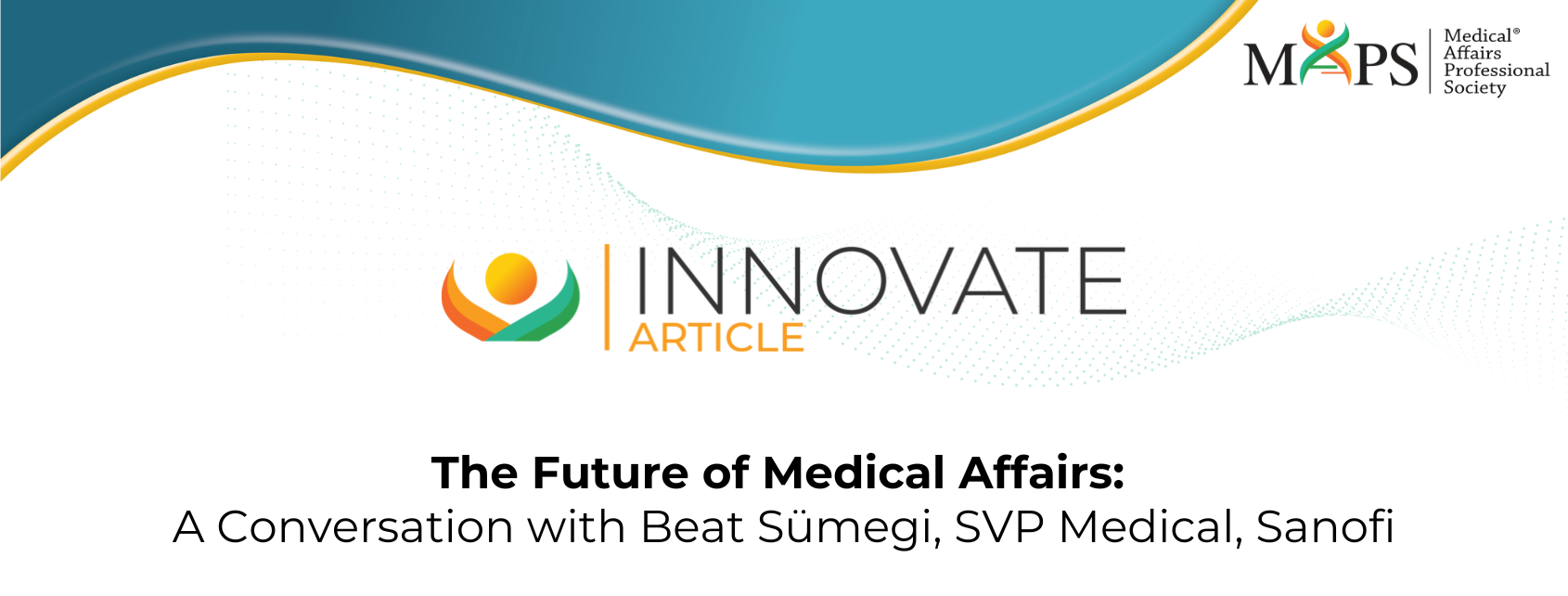As the Medical Affairs function expands to include new roles, organizations and individuals are innovating to keep pace. Here, the Medical Affairs Professional Society (MAPS) speaks with Beat Sümegi, SVP Medical with Sanofi, about major areas of change and the need to help Medical Affairs professionals build new skills to succeed in this world of increased responsibility and opportunity.
MAPS: First, could you tell us a little about yourself and how you came to your position at Sanofi?
Sümegi: I worked for 25 years with Novartis in R&D, Commercial, General Management and Medical Affairs. This broad experience enabled me to understand and value the importance of Medical Affairs for our industry and the synergies possible with many other functions. In one of my previous roles, as Global Head of Medical Strategy, I was tasked to transform and evolve our traditional Medical Affairs operational model at Novartis. The Novartis Pharma CMO at that time and my manager, Ameet Nathwani, who had joined Sanofi during 2016 as CMO and ExCom member, asked if I could consider a similar task and role with Sanofi as well. Intrigued by the vision Ameet and the Sanofi CEO at that time, Olivier Brandicourt, shared regarding the evolution of Medical Affairs, I joined Sanofi in 2017 as Global Head of Medical Operations and Effectiveness. This role includes responsibility for Medical Information, Field Medical Effectiveness, Capabilities and Learnings, Medical Governance, Medical Operations, the Medical Transformation Office and our Medical Activities Hub. The Medical Activities Hub is a medical service center that we set up in a record time of only six months in India. During its current first phase, it is creating scientific communication and educational content (also digital), supporting review and approval processes and providing analytical support. It’s a role that allows me to look at the big picture while still leading teams that directly deliver on the promise of Medical Affairs.

Beat Sümegi
MAPS: And what do you see as major areas of this promise?
Sümegi: The biggest transformation I see is the evolution of the strategic partnership with R&D and Commercial. Really, there are two key elements driving this transformation. First is realizing the importance of insights generated by Medical Affairs – our function tends to be closest to external medical and scientific stakeholders and patients and is therefore best positioned to generate insights from these communities on how medicines are being used in different settings and patient populations and what medical needs exist. The insights being generated by these touchpoints are critical and in the last few years as our industry has recognized this fact, Medical Affairs has become increasingly important in shaping our development and our commercial strategies. Companies leveraging the insights from their Medical Affairs teams are winning companies.
MAPS: You mentioned a second factor propelling Medical in strategic partnerships with R&D and Commercial…
Sümegi: The second is the evolution related to data analytics and evidence generation. Non-interventional trials such as Real World Evidence (RWE) studies as a source of scientific and medical data have become a critical element in our Integrated Evidence Generation Planning.
MAPS: Can you give us an example?
Sümegi: Sure, take classical randomized controlled clinical trials. It often takes years to create data from such trials, but a RWE study monitoring the real use of a new drug and its effects in a specific patient population, exposed to current standard of care, could return results in a few months only and provides you with supportive real-life data, unbiased by a formalized controlled trial set-up and guaranteeing a fast paced scientific news-flow. The recognition of RWE data also by regulatory authorities, such as the FDA, as a reliable data source to support label changes has further enhanced their importance.
MAPS: When we talk about RWE, the discussion used to be limited to insurance databases or other datasets like SEER registries. Do you see the emergence of additional sources for RWE?
Sümegi: Absolutely. One interesting example is social media – using it as a pool to generate data or look into the rise of certain opinions or events or sentiments can be very complementary to analyzing real life data from hospital or insurance databases. Take the flu. I’m sure you’ve seen the example of epidemiologists using social media monitoring tools to map flu and other illness outbreaks based on the RWE of publicly posted messages. Additionally, Medical Affairs teams are starting to use social media as a performance indicator – as a new “impact” KPI – for example, to see how well a message penetrates into stakeholder segments and what sentiments it triggers. Of course, social media is just one example of many new sources of data, which can be used to complement classic RWE approaches.
MAPS: With Medical Affairs generating new insights, new evidence and new messages, how is industry integrating this information?
Sümegi: The spectrum of Medical Affairs activities used to start around late phase 3 drug development, and that has changed. MA is starting to get involved by bringing stakeholder perspectives and insights to early phases of R&D, allowing, for example, patients and the patient experiences to influence directions of drug development. Then there is the new frontier of modeling. Ultimately, we are going into a world in which we may be able to replace some of the patient studies we are doing with in vitro modeling – modeling drug effectiveness through in vitro clinical trials based on cell models and computed biologic processes. These are tremendous opportunities to significantly accelerate future drug developments and the generation of scientific data.
MAPS: These new strategies in data generation and evaluation must lead to new strategies in evidence dissemination as well?
Sümegi: Definitely. This Insight and Evidence Generation process leads to creating key messages out of your scientific data. In the old days, Medical focused almost exclusively on physicians and today a fully-fledged MA group is targeting all of the external stakeholders including patients, hospitals, societies, payors, governments, etc., the full spectrum of customers out there that has to be addressed. This brings complexity. You need to tailor your interactions to each of these customer channels. It’s a bit like the healthcare trend toward personalized medicine: Recognition of the need to personalize the communications and education we deliver to various categories of external stakeholders has catapulted the Medical Affairs function into a new stage and new position within the biopharmaceutical industry.
MAPS: You see personalized stakeholder interactions as an opportunity for Medical Affairs?
Sümegi: What we are seeing today around digital is a fantastic opportunity. Our stakeholders now expect a tailored digital experience: Multi channel engagement models to interact with stakeholders through digital platforms, while adjusting content to individual requirements. It’s like the tailored experience Amazon provides to customers. Imagine you have a company platform, where each of our stakeholder segments have their own “space,” receiving tailored product and disease information, education, news about events such as congresses, latest publications, opportunities to interact with experts, etc. For example, a physician searching for information about our latest breast cancer treatment. Next time the physician goes in, the platform will be prepared for him or her, offering information on upcoming and latest breast cancer events at congresses, new publications, recent approvals, new educational opportunities, etc. This is not only possible – it’s happening right now. We shall be able to collect stakeholder data with all our digital touchpoints, of course in compliance with existing rules and regulations. These data will enable us to understand better our stakeholders’ needs and expectations. Ultimately it will be possible also through targeted analytics and modeling to predict such needs and expectations and tailor scientific information, communication and education offerings accordingly.
MAPS: Do you see changes in your active engagement strategies as well?
Sümegi: Digital is transforming not only the way we perform events, content management and communication, but education, as well. Take preceptorship programs. We used to bring 20-30 doctors to a hospital for two or three days of programs detailing new treatment strategies for patients related to a certain disease. Now with new technologies, we have the ability to bring these hospital-based events into the physician’s office or home. And if they choose, technologies like virtual reality or avatar technology you can have, for example, a professor in Germany sitting in a hospital environment next to you virtually and answering questions for participants from around the world.
MAPS: How do you feel about digital interactions replacing face-to-face conversations?
Sümegi: Some people say nothing can replace FTF interactions and that may be true – it’s in the nature of humans to want direct and tangible contact in our interactions. But you can support these FTF interactions with digital. Look at societies like ESC, ASCO and AACR going to hybrid congress models. Though I could be wrong, I think in the future this hybrid model of FTF supported by digital will become the dominant model.
MAPS: You’ve talked about the opportunity for Medical Affairs to help the pharmaceutical industry realize the promise of insights generated from external stakeholders. Do you also see opportunities to transform the way we reach our internal audiences?
Sümegi: What we shouldn’t forget when we paint the future is that we don’t want Medical Affairs professionals to feel like they have to be superhumans to manage these changes, these technologies, these new approaches. Many people in our profession come from R&D or have been working as physicians, meaning they are comfortable with traditional approaches. We have to make sure the next generation of Medical Affairs professionals is well prepared for new practices and understand the new opportunities, integrating them into their work but also understanding and being able to manage related risks. One opportunity afforded already now by digital is to include internal people in some of the same virtual trainings we offer to external stakeholders. For example, when an organization is starting to develop a medicine in a rare disease even our MA professionals who have studied medicine might not know about the treatment landscape and we can invite these internal audiences to learn about emerging treatments along with our external stakeholders. We have the opportunity to accelerate the function, but as we do so, we need to ensure the people who power the function – truly our most important asset – are not left behind.



